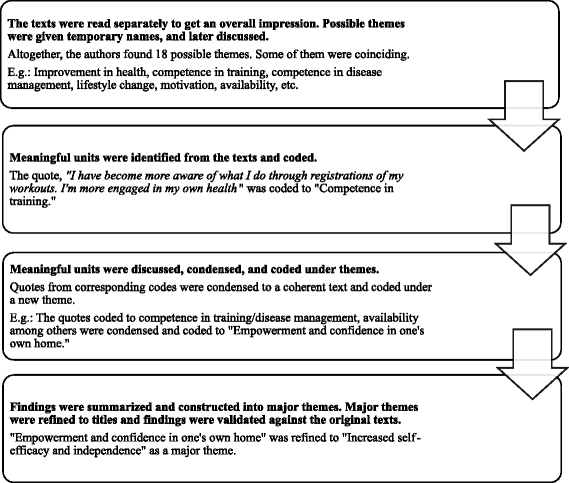Adherence and factors affecting satisfaction in long-term telerehabilitation for patients with chronic obstructive pulmonary disease: a mixed methods study
- PMID: 26911326
- PMCID: PMC4766676
- DOI: 10.1186/s12911-016-0264-9
Adherence and factors affecting satisfaction in long-term telerehabilitation for patients with chronic obstructive pulmonary disease: a mixed methods study
Abstract
Background: Telemedicine may increase accessibility to pulmonary rehabilitation in chronic obstructive pulmonary disease (COPD), thus enhancing long-term exercise maintenance. We aimed to explore COPD patients' adherence and experiences in long-term telerehabilitation to understand factors affecting satisfaction and potential for service improvements.
Methods: A two-year pilot study with 10 patients with COPD was conducted. The intervention included treadmill exercise training at home and a webpage for telemonitoring and self-management combined with weekly videoconferencing sessions with a physiotherapist. We conducted four separate series of data collection. Adherence was measured in terms of frequency of registrations on the webpage. Factors affecting satisfaction and adherence, together with potential for service improvements, were explored through two semi-structured focus groups and an individual open-ended questionnaire. Qualitative data were analysed by systematic text condensation. User friendliness was measured by the means of a usability questionnaire.
Results: On average, participants registered 3.0 symptom reports/week in a web-based diary and 1.7 training sessions/week. Adherence rate decreased during the second year. Four major themes regarding factors affecting satisfaction, adherence and potential improvements of the intervention emerged: (i) experienced health benefits; (ii) increased self-efficacy and independence; and (iii) emotional safety due to regular meetings and access to special competence; (iv) maintenance of motivation. Participants were generally highly satisfied with the technical components of the telerehabilitation intervention.
Conclusions: Long-term adherence to telerehabilitation in COPD was maintained for a two-year period. Satisfaction was supported by experienced health benefits, self-efficacy, and emotional safety. Maintenance of motivation was a challenge and might have affected long-term adherence. Four key factors of potential improvements in long-term telerehabilitation were identified: (i) adherence to different components of the telerehabilitation intervention is dependent on the level of focus provided by the health personnel involved; (ii) the potential for regularity that lies within the technology should be exploited to avoid relapses after vacation; (iii) motivation might be increased by tailoring individual consultations to support experiences of good health and meet individual goals and motivational strategies; (iv) interactive functionalities or gaming tools might provide peer-support, peer-modelling and enhance motivation.
Figures
References
-
- Global Initiative for Chronic Obstructive Lung Disease (GOLD). Global strategy for the diagnosis, management and prevention of chronic obstructive pulmonary disease: Global initiative for chronic obstructive lung disease, Inc.; 2015 [05.01.2015]. Available from: http://www.goldcopd.org/uploads/users/files/GOLD_Report_2014_Jan23.pdf. - PubMed
-
- NHS Right Care. Introducing the atlas of variation in healthcare for people with respiratory disease 2012 [23.03.2015]. Available from: http://www.rightcare.nhs.uk/index.php/atlas/respiratorydisease/.
Publication types
MeSH terms
LinkOut - more resources
Full Text Sources
Other Literature Sources
Medical




